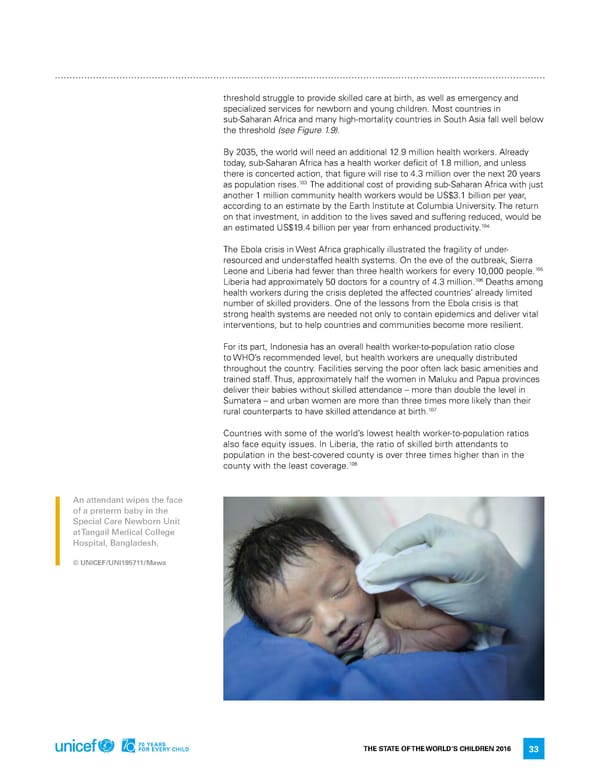threshold struggle to provide skilled care at birth, as well as emergency and specialized services for newborn and young children. Most countries in sub-Saharan africa and many high-mortality countries in South asia fall well below the threshold (see Figure 1.9). By 2035, the world will need an additional 12.9 million health workers. already today, sub-Saharan africa has a health worker deficit of 1.8 million, and unless there is concerted action, that figure will rise to 4.3 million over the next 20 years 103 as population rises. The additional cost of providing sub-Saharan africa with just another 1 million community health workers would be US$3.1 billion per year, according to an estimate by the earth institute at Columbia University. The return on that investment, in addition to the lives saved and suffering reduced, would be an estimated US$19.4 billion per year from enhanced productivity.104 The ebola crisis in West africa graphically illustrated the fragility of under- resourced and under-staffed health systems. on the eve of the outbreak, Sierra leone and liberia had fewer than three health workers for every 10,000 people.105 106 liberia had approximately 50 doctors for a country of 4.3 million. deaths among health workers during the crisis depleted the affected countries’ already limited number of skilled providers. one of the lessons from the ebola crisis is that strong health systems are needed not only to contain epidemics and deliver vital interventions, but to help countries and communities become more resilient. for its part, indonesia has an overall health worker-to-population ratio close to Who’s recommended level, but health workers are unequally distributed throughout the country. facilities serving the poor often lack basic amenities and trained staff. Thus, approximately half the women in Maluku and Papua provinces deliver their babies without skilled attendance – more than double the level in Sumatera – and urban women are more than three times more likely than their rural counterparts to have skilled attendance at birth.107 Countries with some of the world’s lowest health worker-to-population ratios also face equity issues. in liberia, the ratio of skilled birth attendants to population in the best-covered county is over three times higher than in the 108 county with the least coverage. An attendant wipes the face of a preterm baby in the Special Care Newborn Unit at Tangail Medical College Hospital, Bangladesh. © UNICEF/UNI195711/Mawa The STaTe of The World’S Children 2016 33
 70 Years for Every Child Page 47 Page 49
70 Years for Every Child Page 47 Page 49